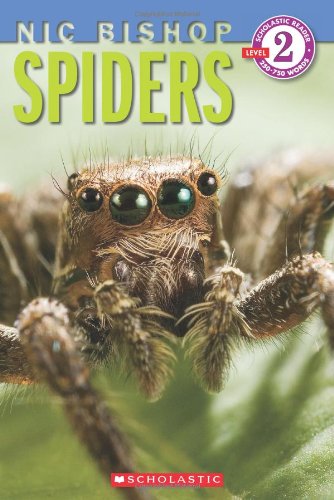-
Spiders
Gail Gibbons
Paperback (Holiday House, Jan. 1, 1993)Weaving webs, digging burrows, and floating on strands of silk—spiders are fascinating creatures! From tiny baby spiderlings to large tarantulas, nonfiction master Gail Gibbons' introduction to these intriguing arachnids reminds us that even when they look scary, most spiders are harmless—and even helpful! There are over thirty thousand kinds of spiders in the world—small and large, colorful or gray—and they live, hunt, and adapt in different ways. A number of different species and spider behaviors are highlighted in this book, accompanied by clear, labeled illustrations and important vocabulary. Filled with interesting trivia and information on the history of spiders, as well as an explanation of the difference between spiders and insects, this is a great introduction that takes the fear out of our eight-legged, web-spinning friends. L
L
-
Spiders
Nic Bishop
Paperback (Scholastic Paperbacks, Sept. 1, 2012)Nic Bishop's Sibert Honor book, adapted for the youngest readers.Spiders are meat eaters, like lions and tigers. But they are much more scary! Tarantulas lurk on the rain forest floor. Lynx spiders hunt among the leaves. Their spider senses know when prey is near. Now even the youngest readers can join Sibert Medal-winning photographer and biologist Nic Bishop as he takes a closer look at the world's most amazing animals. In this book, Nic introduces fun facts about spiders and their bodies, habits, and life cycle. The simple, easy-to-read text is perfect for beginners, and the eye-catching photographs will delight naturalists of all ages. This reader includes a brief author's note, glossary, and accessible visual index. M
M
-
Super Spiders
Charlotte Guillain
language (Raintree, Dec. 21, 2015)How do spiders make their webs? How do spiders eat their prey? How many eyes do spiders have? This title takes a fun look at spiders through engaging photos and lively text. T
T
-
Spiders
Seymour Simon
Paperback (Collins, Oct. 16, 2007)They’re creepy, they’re crawly, and they’re absolutely fascinating! Award-winning science writer Seymour Simon’s engaging narrative, combined with up–close, visually arresting photographs give the readers an insider’s look into the spiders’ world as they spin webs, capture prey, and mate. Find out how spiders are essential to the environment and why they don’t have to frighten you in this updated edition. This nonfiction picture book is an excellent choice to share during homeschooling, in particular for children ages 6 to 8. It’s a fun way to learn to read and as a supplement for activity books for children.Seymour Simon knows how to explain science to kids and make it fun. He was a teacher for more than twenty years, has written more than 250 books, and has won multiple awards.This book includes an author's note, glossary, and index and supports the Common Core Learning Standards, Next Generation Science Standards, and the Science, Technology, Engineering, and Math (STEM) standards. W
W
-
Spider!
Carrie Hyatt, Tatiana Kamshilina
Paperback (Write For Kids, Aug. 6, 2019)Get your vocal cords ready because this book makes everyone shout, "SPIDER!" A silly librarian guides readers through this interactive story. She invites them to speak on behalf of a boy frozen in fear and speechless at the sight of a spider. An adorable arachnid friend gives up his space in the park for a gentle mom with a fearful son.
-
Spiders
Tom Hoyle
eBook (Macmillan Children's Books, Nov. 6, 2014)From the author of Thirteen, Tom Hoyle's Spiders is a creepy, spine-tingling thriller that will leave you breathless, perfect for fans of Michael Grant.Adam may have survived once, but a cult still has him in its sights. And this time he may not escape with his life . . .Abbie's dad is an undercover agent, tasked with exposing dangerous cults. He's normally able to maintain his distance, but this time Abbie's worried he's in too deep. Megan was sure she and Adam were safe, but now he's missing and she's the only one who can help him . . . The web is closing in around them . . .
-
Spiders
Gail Gibbons
Hardcover (Holiday House, March 1, 1993)Spiders help us by eating insects that are harmful to people and crops. From baby spiderlings to large tarantulas, here is information about ballooning, molting, and how different spiders build their webs. Spiders have been on earth since before the first dinosaurs. About 30,000 kinds of these creatures are known to be living, and more are still being discovered. L
L
-
Spiders
Rebecca Gilpin
Hardcover (Usborne Publishing Ltd, March 15, 2001)BRAND NEW, Exactly same ISBN as listed, Please double check ISBN carefully before ordering.
-
Spinning Spiders
Melvin Berger, S. D. Schindler
Paperback (HarperCollins, May 6, 2003)How do spiders spin such large webs? Spiders produce a unique silk that can stretch from wall to wall, or between the legs of a chair. In this book, featuring remarkably realistic artwork by S.D. Schindler, you will learn about the silk spiders produce, the webs they spin, and the prey they capture. You will even learn how to make a web of your own! This nonfiction picture book is an excellent choice to share during homeschooling, in particular for children ages 5 to 7. It’s a fun way to learn to read and as a supplement for activity books for children.This is a Level 2 Let’s-Read-and-Find-Out Science title, which means the book explores more challenging concepts for children in the primary grades and supports the Common Core Learning Standards, Next Generation Science Standards, and the Science, Technology, Engineering, and Math (STEM) standards. Let’s-Read-and-Find-Out is the winner of the American Association for the Advancement of Science/Subaru Science Books & Films Prize for Outstanding Science Series. O
O


